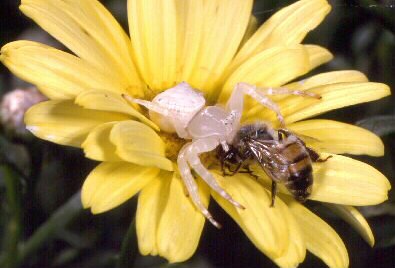Flower Spider
Category: Arachnida Spider

Facts about Flower Spiders, "Scientific name for Flower Spider is Thomisus spectabilis". Flower Spider is also known as the crab spider as it’s legs are stout and look like that of crab. Mostly they are white or yellow in color. Some of them have green, brown and rosy marks on abdomen. The male Flower Spider are quite smaller than the females. Legs of the male Flower Spider are longer than that of females. They have a pair of eyes in the front and well developed eye sight.
Flower Spiders take flowers as their hunting regions. They wait on the petals with their legs being used as anchors for insects. An insect visiting the same flower on which the spider hides gets bitten and sucked till it dries. Flower spiders are common in summer and they are believed to be active in the day time only.
All kind of nectar feeding small insects fall prey to flower spiders and they even eat bees. The front long legs help holding the prey and to jump long distances to appear on the sight unnoticed.
The female Flower Spider lays eggs on a silk dish weaved by itself while it was being prepared. Once done with the laying eggs, she weaves a lid like structure to fit the dish. This new enclosed structure with its eggs inside is its egg sac. The eggs look greenish and it takes about two weeks to hatch Flower Spider-lings. They are left to survive for themselves.
Flower spiders are quick responsive regarding their safety matters. Their bite causes mild pain in the bitten region. The venom works locally, but enough of that venom could be deadly.
The best thing about these flower spiders is they can change their color between white and yellow to camouflage. The female Flower Spider are very good at it and its females that are mostly seen outside. The males aren't seen much outside.
Flower Spiders have oversize brains.
In the Flower Spider the oxygen is bound to "hemocyanin" a copper-based protein that turns their blood blue, a molecule that contains copper rather than iron. Iron-based hemoglobin in red blood cells turns the blood red
Flower Spiders have two body parts, the front part of the body is called the Cephalothorax-(the thorax and fused head of spiders). Also on this part of the body is the Flower Spider’s gland that makes the poison and the stomach, fangs, mouth, legs, eyes and brain. Flower Spiders also have these tiny little leg-type things called (pedipalps) that are next to the fangs. They are used to hold food while the spider bites it. The next part of the Flower Spiders body is the abdomen and the abdomens back end is where there is the spinnerets and where the silk producing glands are located.
The muscles in a Flower Spiders legs pull them inward, but the spider can't extend its legs outward. It will pump a watery liquid into its legs that pushes them out. A Flower Spider’s legs and body are covered with lots of hair and these hairs are water-repellent, which trap a thin layer of air around the body so the Flower Spiders body doesn't get wet. It allows them to float, this is how some spiders can survive under water for hours. A Flower Spider feels its prey with chemo sensitive hairs on its legs and than feels if the prey is edible. The leg hair picks up smells and vibrations from the air. There are at minimum, two small claws that are at the end of the legs. Each Flower Spiders leg has six joints, giving the spider 48 leg joints. The Flower Spider’s body has oil on it, so the spider doesn't stick to it’s own web.
A Flower Spiders stomach can only take liquids, so a spider needs to liquefy their food before they eat. They bite on their prey and empty its stomach liquids into the pray which turns it into a soup for them to drink.
Spiders do not have a skeletons. They have a hard outer shell called an exoskeleton-(a rigid external covering for the body in some invertebrate animals). The exoskeleton is hard, so it can’t grow with the spider. The young Flower Spiders need to shed their exoskeleton. The Flower Spider has to climb out of the old shell through the cephalothorax. Once out, they must spread themselves out before the new exoskeleton will harden. Know they have some room to grow. They stop growing once they fill this shell. Female Flower Spiders are usually bigger than males.
Female Flower Spiders lay eggs on a bed of silk, which she creates right after mating. Once the female Flower Spider lays her eggs, she will than cover them with more silk.
A male Flower Spider has two appendages called "pedipalps" a sensory organ, instead of a penis, which is filled with sperm and insert by the male into the female Flower Spider’s reproductive opening.
Spiders belong to a group of animals called "arachnids", mites and Scorpions and a tick is also in the arachnid family. An Arachnids is a creature with eight legs, two body parts, no antennae or wings and are not able to chew on food. Spiders are not insects because insects have three main body parts and six legs and most insects have wings.
The Arachnids are even in a larger group of animals called "arthropods" an invertebrate animal of the large phylum Arthropoda, which also include spiders, crustaceans and insects. They are the largest group in the animal world, about 80% of all animals come from this group. There are over a million different species. There are more than 40,000 different types of spiders in the world.

 Back To Category Arachnida Spider
Back To Category Arachnida Spider